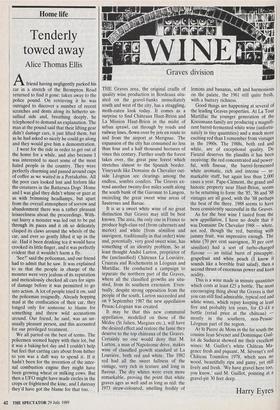Graves division
THE Graves area, the original cradle of quality wine production in Bordeaux situ- ated on the gravel-banks immediately south and west of the city, has a straggling, moth-eaten look today. It comes as a surprise to find Châteaux Haut-Brion and La Mission Haut-Brion in the midst of urban sprawl, cut through by roads and railway lines, flown over by jets en route to and from the airport at Merignac. The expansion of the city has consumed no less than four and a half thousand hectares of vines this century. Further south the forest takes over, the great pine forest which stretches almost to the Spanish border. Vineyards like Domaine de Chevalier out- side Leognan are clearings among the endless, sombre conifers. The Graves ex- tend another twenty-five miles south along the south bank of the Garonne to Langon, encircling the great sweet wine areas of Sauternes and Barsac.
It is as a sweet white wine of no great distinction that Graves may still be best known. The area, the only one in France to produce high-class red (from cabernets and merlot) and white (from semillon and sauvignon, traditionally in that order) wine and, potentially, very good sweet wine, has something of an identity problem. So at least thought Andre Lurton, proprietor of the (unclassified) Châteaux La Louviere, Cruzeau and Rochemorin in Leognan and Martillac. He conducted a campaign to separate the northern part of the Graves, where all the classified growths are situ- ated, from its southern extension. Even- tually, despite strong opposition from the people of the south, Lurton succeeded and on 9 September 1987 the new appellation Pessac-Leognan was created.
It may be that this new communal appellation, modelled on those of the Medoc (St Julien, Margaux etc.), will have the desired effect and restore the fame they deserve to the top châteaux of the Graves. Certainly no one would deny that M. Lurton, a man of Napoleonic drive, makes wine of classified growth standard at La Louviere, both red and white. The 1982 red had all the sweet fullness of the vintage, very rich in texture and long in flavour. The dry whites were even more remarkable, proving the point that white graves ages as well and as long as red: the 1973 straw-coloured, smelling freshly of lemons and bananas, soft and harmonious on the palate, the 1961 still quite fresh, with a buttery richness. Good things are happening at several of the leading Graves properties. At La Tour Martillac the younger generation of the Kressmann family are producing a magnifi- cent barrel-fermented white wine (unfortu- nately in tiny quantities) and a much more exciting red than I remember from vintages in the 1960s. The 1988s, both red and white, are of exceptional quality. De Fieuzal deserves the plaudits it has been receiving: the red concentrated and power- ful, with finesse, the barrel-fermented white aromatic, rich and intense — re- markable stuff, but again less than 2,000 cases a year. Pape-Clement, the grand and historic property near Haut-Brion, seems to be returning to form: the '85, '86 and '88 vintages are all good, with the '88 perhaps the best of the three. 1988 seems to have been consistently successful in the Graves.
As for the best wine I tasted from the new appellation, I have no doubt that It was Domaine De Chevalier 1988 — white, not red, though the red, bursting with jammy fruit, was impressive enough. The white (70 per cent sauvignon, 30 per cent semillon) had a sort of turbo-charged flavour — an initial burst of pineapple, grapefruit and white peach (I know it sounds like a horrible fruit salad), then a second thrust of enormous power and keen acidity.
This is a wine made in minute quantities which costs at least £25 a bottle. The most encouraging thing about the Graves is that you can still find admirable, typical red and white wines, which repay keeping at least five and probably ten years, for £344 a bottle (retail price at the château) — mostly in the southern, non-Pessac- Leognan part of the region.
At St Pierre de Mons in the far south the cousins Jean Sevenet and Dominique Guil- lot de Suduirat showed me their excellent wines: M. Guillot's white Château Ma- gence fresh and piquant, M. Sevenet's red Chateau Toumilon 1978, which sees no wood, beautifully ripe and gamy, yet still lively and fresh. 'We have gravel here too, you know,' said M. Guillot, pointing at a gravel-pit 30 feet deep.
Harry Eyres


















































 Previous page
Previous page